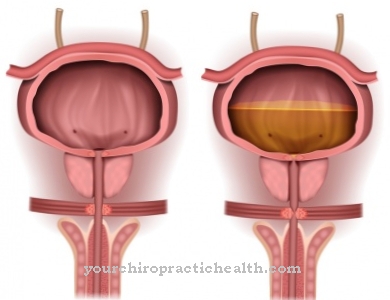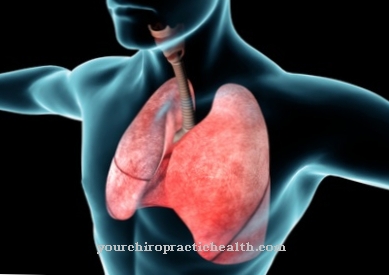As Biotransformation is a process in the metabolism in which substances that cannot be excreted are converted into excretable products with the help of chemical processes.
What is the biotransformation?

During biotransformation, lipophilic substances are converted into more hydrophilic substances. The transformation subsequently enables elimination.
The reactions that are necessary for biotransformation take place primarily in the liver. Overall, a biotransformation consists of two different phases.
Function & task
In the human organism, in the course of physiological metabolism, substances repeatedly accumulate that cannot be excreted in the stool or urine. These substances are very often lipophilic (for example steroid hormones and bile pigments), that is, they are not or only very poorly soluble in water. Furthermore, the body also absorbs foreign substances or synthesized substances such as medication or drugs with food. If these substances were to accumulate in the body, it would be fatal. Therefore, it is necessary to convert it into an excretable form. This process is known as biotransformation.
The biotransformation consists of two different phases: Phase I reactions insert functional groups into foreign substances or metabolites with the help of the heme protein cytochrome P450 enzyme. Due to the large number of toxins, there is also a large number of CYP 450. One enzyme is able to convert many substances. In the first phase, toxins are neutralized and then broken down into small molecules.
In the next phase, these are then made water-soluble and can be excreted via breath, urine or sweat secretion. In the second phase, the intermediate products or foreign substances from phase I are combined with water-soluble substances. This can increase their water solubility. In addition, the reaction products are detoxified and excreted.
After phase II, transport processes take place via the lymphatic system, the bloodstream and transport proteins, although in some cases there is no metabolism. Furthermore, various reactions such as the breakdown of GSS6 / GSH to glucomate, cysteine or N-acetylcysteine occur.
The membrane transport is carried out with the help of special carriers, such as the multidrug resistance-related proteins. The products that emerge in phase II are called conjugates. These biologically active or toxic substances are not specifically recognized as such by the body. Rather, the process is due to the enzymes, which have a very low substrate specificity. This causes reactions in an entire group of substances.
Illnesses & ailments
However, the process of biotransformation also entails risks. In this way, a harmless substance can also be converted into a toxin. An example of this would be aflatoxin B1, which comes from the so-called Aspergillus flavus, which is found in poorly stored pistachios, peanuts or corn. The molecule produced by the fungus is initially inactive and gets into the liver with food. There it is changed by the cytochrome P450 enzyme into a metabolite that has a carcinogenic effect.
When a substance is biotransformed into a toxic metabolite, this process is called poisoning. Another example of this is methanol, which is usually not toxic. However, when it is broken down, it is transformed into formaldehyde or formic acid.
Morphine produces the so-called morphine-6-glucuronide in the liver, which has an even stronger effect than morphine. These conversion effects are also called first-pass effects.
The process also affects medication. Due to the metabolism, these lose their activity and are extracted from the blood of the portal vein by the liver. However, toxicity can also result here, an example of which would be the metabolism of paracetamol and alcohol. Since the breakdown of alcohol and some drugs takes place via the same microsomal ethanol-oxidizing system, the effects of drugs in combination with alcohol can be potentiated.
Disorders of the biotransformation occur on three different levels:
- due to an increased or decreased activity of so-called microsomal enzymes (mainly in phase I)
- due to disorders of biliary excretion
- due to decreased absorption of xenobiotics in the cells of the liver.
The process of converting lipophilic substances into hydrophilic substances is also used in the body's own molecules such as bilirubin or steroid hormones. This inactivates them and subsequently excretes them. In the case of chronic liver insufficiency, however, the estrogens cannot be inactivated or excreted, which leads to an accumulation in the body.
Bilirubin is produced when porphyrins are broken down. In higher concentrations it has a toxic effect and should therefore be eliminated from the organism. However, transport disorders can occur here, including for example Gilbert-Meulengracht syndrome, Rotor syndrome or Dubin-Johnson syndrome.
Disorders of the biotransformation can also occur in premature or newborn babies. The glucuronidation capacity of the liver is not yet sufficiently developed, so that drugs or bilirubin can only be insufficiently converted and excreted. Certain liver diseases such as cirrhosis or hepatitis can also impair the activity of the biotransformation enzymes. In most cases, phase I reactions are more affected than those of phase II. Here too, drugs are converted and excreted more slowly, which extends their half-life, which should also be taken into account therapeutically.



























